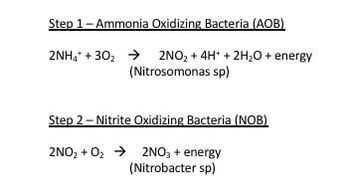No matter which organisms are removing ammonia and nitrite, the following checklist comes from working wastewater treatment plants that achieve ammonia and nitrite oxidation.
- Typically in the field 70-80% organic reduction should have occurred prior to trying nitrification. Usually COD levels at effluent should be 100-150 mg/L while BOD < 40 mg/L.
- The majority of organics must be degraded since the biomass contains 93-97% heterotrophs and 3-7% chemoautotrophs. Thus, if high carbon content is present, the heterotrophic organisms will out-compete the slower growing autotrophic nitrifying bacteria for essential nutrients.
- Rule of Thumb: As the BOD:TKN ratio decreases, nitrification kinetics increase.
- Dissolved Oxygen (DO) is vitally important. Although critical DO (in vitro) is 0.2 mg/L, field DO should never drop below 0.5 mg/L. Optimal range is >2.0 mg/L for no inhibition whatsoever.
- The oxygen required to oxidize 1 gram of NH3-N to NO2-N is approximately 3.5 grams O2. From NO2-N to NO3-N, it is 1 gram of O2 per gram of NO2-N.
pH 6.5-8.5, 7.2 - 7.8 is optimum for MLSS
Temperature 10 - 38 Deg C, 30 Deg C optimum
Effluent BOD5 < 30 mg/L
Effluent COD <100-150 mg/L
Effluent TOC <45 mg/L
MLSS 2,500 mg/L
Sludge Age (MCRT) 5 - 15 days
DO >2.0 mg/L, 2.0 - 4.0 in systems subject to shock


 RSS Feed
RSS Feed